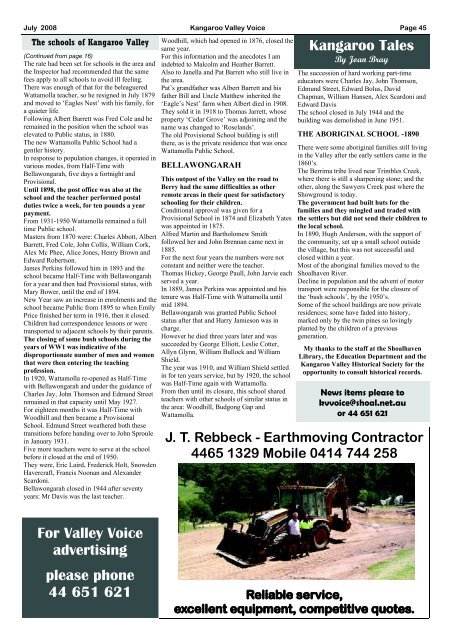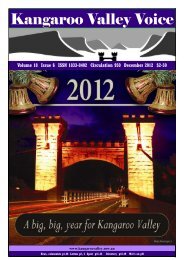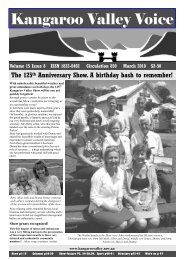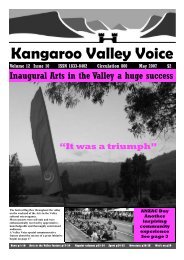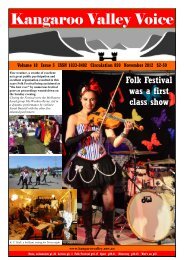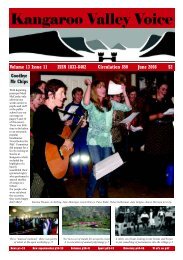Kangaroo Valley Voice - Lazyfish Technology
Kangaroo Valley Voice - Lazyfish Technology
Kangaroo Valley Voice - Lazyfish Technology
Create successful ePaper yourself
Turn your PDF publications into a flip-book with our unique Google optimized e-Paper software.
July 2008 <strong>Kangaroo</strong> <strong>Valley</strong> <strong>Voice</strong> Page 45The schools of <strong>Kangaroo</strong> <strong>Valley</strong>(Continued from page 16)The rate had been set for schools in the area andthe Inspector had recommended that the samefees apply to all schools to avoid ill feeling.There was enough of that for the beleagueredWattamolla teacher, so he resigned in July 1879and moved to ‘Eagles Nest’ with his family, fora quieter life.Following Albert Barrett was Fred Cole and heremained in the position when the school waselevated to Public status, in 1880.The new Wattamolla Public School had agentler history.In response to population changes, it operated invarious modes, from Half-Time withBellawongarah, five days a fortnight andProvisional.Until 1898, the post office was also at theschool and the teacher performed postalduties twice a week, for ten pounds a yearpayment.From 1931-1950 Wattamolla remained a fulltime Public school.Masters from 1870 were: Charles Abbott, AlbertBarrett, Fred Cole, John Collis, William Cork,Alex Mc Phee, Alice Jones, Henry Brown andEdward Robertson.James Perkins followed him in 1893 and theschool became Half-Time with Bellawongarahfor a year and then had Provisional status, withMary Bower, until the end of 1894.New Year saw an increase in enrolments and theschool became Public from 1895 to when EmilyPrice finished her term in 1916, then it closed.Children had correspondence lessons or weretransported to adjacent schools by their parents.The closing of some bush schools during theyears of WW1 was indicative of thedisproportionate number of men and womenthat were then entering the teachingprofession.In 1920, Wattamolla re-opened as Half-Timewith Bellawongarah and under the guidance ofCharles Jay, John Thomson and Edmund Streetremained in that capacity until May 1927.For eighteen months it was Half-Time withWoodhill and then became a ProvisionalSchool. Edmund Street weathered both thesetransitions before handing over to John Sproulein January 1931.Five more teachers were to serve at the schoolbefore it closed at the end of 1950.They were, Eric Laird, Frederick Holt, SnowdenHavercraft, Francis Noonan and AlexanderScardoni.Bellawongarah closed in 1944 after seventyyears: Mr Davis was the last teacher.Woodhill, which had opened in 1876, closed thesame year.For this information and the anecdotes I amindebted to Malcolm and Heather Barrett.Also to Janella and Pat Barrett who still live inthe area.Pat’s grandfather was Albert Barrett and hisfather Bill and Uncle Matthew inherited the‘Eagle’s Nest’ farm when Albert died in 1908.They sold it in 1918 to Thomas Jarrett, whoseproperty ‘Cedar Grove’ was adjoining and thename was changed to ‘Roselands’.The old Provisional School building is stillthere, as is the private residence that was onceWattamolla Public School.BELLAWONGARAHThis outpost of the <strong>Valley</strong> on the road toBerry had the same difficulties as otherremote areas in their quest for satisfactoryschooling for their children.Conditional approval was given for aProvisional School in 1874 and Elizabeth Yateswas appointed in 1875.Alfred Martin and Bartholomew Smithfollowed her and John Brennan came next in1885.For the next four years the numbers were notconstant and neither were the teacher.Thomas Hickey, George Paull, John Jarvie eachserved a year.In 1889, James Perkins was appointed and histenure was Half-Time with Wattamolla untilmid 1894.Bellawongarah was granted Public Schoolstatus after that and Harry Jamieson was incharge.However he died three years later and wassucceeded by George Elliott, Leslie Cotter,Allyn Glynn, William Bullock and WilliamShield.The year was 1910, and William Shield settledin for ten years service, but by 1920, the schoolwas Half-Time again with Wattamolla.From then until its closure, this school sharedteachers with other schools of similar status inthe area: Woodhill, Budgong Gap andWattamolla.<strong>Kangaroo</strong> TalesBy Joan BrayThe succession of hard working part-timeeducators were Charles Jay, John Thomson,Edmund Street, Edward Bolus, DavidChapman, William Hansen, Alex Scardoni andEdward DavisThe school closed in July 1944 and thebuilding was demolished in June 1951.THE ABORIGINAL SCHOOL -1890There were some aboriginal families still livingin the <strong>Valley</strong> after the early settlers came in the1860’s.The Berrima tribe lived near Trimbles Creek,where there is still a sharpening stone; and theother, along the Sawyers Creek past where theShowground is today.The government had built huts for thefamilies and they mingled and traded withthe settlers but did not send their children tothe local school.In 1890, Hugh Anderson, with the support ofthe community, set up a small school outsidethe village, but this was not successful andclosed within a year.Most of the aboriginal families moved to theShoalhaven River.Decline in population and the advent of motortransport were responsible for the closure ofthe ‘bush schools’, by the 1950’s.Some of the school buildings are now privateresidences; some have faded into history,marked only by the twin pines so lovinglyplanted by the children of a previousgeneration.My thanks to the staff at the ShoalhavenLibrary, the Education Department and the<strong>Kangaroo</strong> <strong>Valley</strong> Historical Society for theopportunity to consult historical records.News items please tokvvoice@shoal.net.auor 44 651 621J. T. Rebbeck - Earthmoving Contractor4465 1329 Mobile 0414 744 258For <strong>Valley</strong> <strong>Voice</strong>advertisingplease phone44 651 621Reliable service,excellent equipment, competitive quotes.


